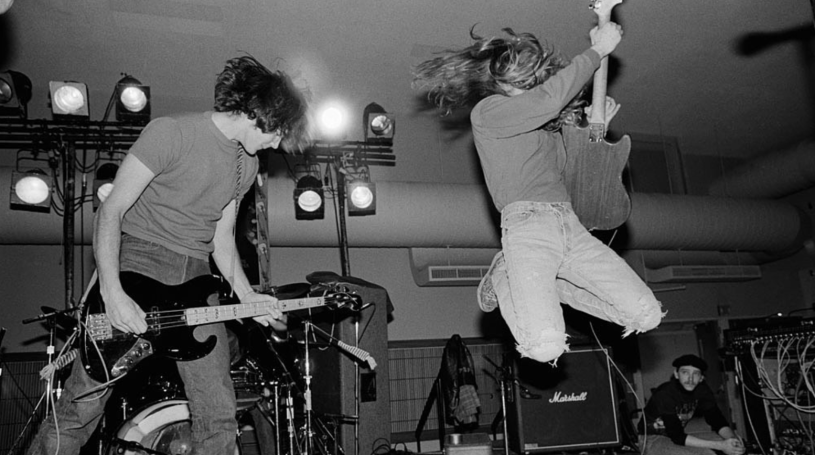By Gabriel Ratio (8C)
Nirvana, Pearl Jam, and Soundgarden are some band names that you have heard before, either from their top hits on the radio, your parents, or maybe a friend explaining their love for them. These bands were all well-known around the world due to the abrasive, intense, and angsty tone associated with their songs. This popularity was due to the Grunge movement, which emerged during the mid-to-late 1980s.
Origins
The Grunge movement stemmed as a subgenre from alternative rock and developed as a subculture in the American Pacific Northwest state of Washington, particularly in Seattle and nearby towns (hence the term, Seattle sound was conceived). Grunge also fuses the elements of heavy metal and punk rock without structure and sometimes speed. This can be displayed with the use of aggressive vocals, heavy and extremely distorted guitar riffs, catchy bass lines, and powerful and energetic drum lines. These would usually depend on the band and which influence they would want to put more emphasis on. Some Grunge bands such as Nirvana preferred more thrash and punk-like sounds, while others like Alice and Chains focused on slow and heavy riffs that are typically associated with metal music.
Arguably, the first grunge band to form was Green River which formed alongside many other bands such as the Melvins or Soundgarden. In 1985, Green River was the first Grunge band to release a record, kickstarting the Seattle music scene and later helping establish the independent record label, “Sub-Pop”. Soon after, in 1987, some of the more popular Grunge bands that we know today were formed. One prominent example is the iconic band Nirvana, formed by Kurt Cobain, along with his friend Krist Novoselic and then drummer Dale Crover. They had a total of five drummers, and their best drummer was Dave Grohl, who joined the band in 1990. Unfortunately, they only lasted until 1994 because of frontman Kurt Cobain’s death at the age of 27 due to suicide.
How Grunge Became the Voice of a Generation
If you ever listened to any song by Grunge bands, you may wonder why the singers would constantly scream and shout at the microphone. You might even feel annoyed due to the loudness and intensity of the songs. Well, that is mainly because the purpose of this movement was to voice out the feelings of generations who felt and suffered from abuse, depression, social and emotional isolation, psychological trauma, and a desire for freedom. This was due to the realism and authenticity of Grunge, as well as the lyrics that were symbolic, heartfelt, and filled with anger, which made it sound like they were screaming and shouting to the ears of the people who simply did not care about these issues at all.
In terms of politics, Grunge also raised awareness of social issues, particularly those that affected younger people. The main themes were usually tolerating differences, supporting and respecting women’s rights, mistrust of authority, and cynicism towards big corporations. Going even further, it even also raised awareness of gay rights and combatted homophobia and sexism. One time, Kurt Cobain even said that he’d wished he’d been gay and often wore dresses to protest against sexism to annoy homophobes.
Lastly, Grunge also affected a lot of younger people, specifically teenagers. This is because it allows an outlet for aggression. It allowed adolescents to experience a cathartic purging of emotions healthily, as well as allowing a movement to stand behind, which also made a rally for like-minded people who listen to the music of these bands. Importantly, teens learned that they did not have to blindly accept what the older generations had told them, and through that, promoted social change.
Grunge also was much more about that angst and the music. It also became an identity. It influenced fashion, movies, literature, and the aforementioned political agenda. Grunge made a point of dressing down out of necessity, wearing flannels, torn jeans, and secondhand clothes, which became a fashion movement. It also influenced movies and documentaries, the most prominent were those about the life and death of Kurt Cobain. It also helped promote beliefs that can help direct people towards independence, which the band Pearl Jam exactly did, promoting and encouraging adolescents and young adults to get involved and participate in politics. Additionally, Pearl Jam also helped spread awareness of Crohn’s disease, played in several health benefit concerts, and promoted environmental sustainability. In short, this is a perfect example of how Grunge bands consistently use their musical platform to evoke changes by spreading awareness and by fighting for what they believe in.
The Decline of Grunge
Sadly, as mentioned in the title, the popularity of the Grunge movement would only be short lived, mainly due to the disappearance or breakups of bands that mainly popularized the genre. The first instance and the most devastating one was Kurt Cobain’s unexpected death on April 5, 1994, due to suicide and drug abuse, which was seen as the end of Grunge for many fans. Pearl Jam stopped performing as a boycott of Ticketmaster for overcharging fans, which lasted three years before performing and touring once again. Soundgarden’s lead singer Chris Cornell was suffering from depression, and due to this, he died at the age of 65 years old in 2017 due to suicide by hanging.
Grunge became the very thing that it sought to rebel against as it was commercialized and popularized. However, despite the fall of the genre’s popularity in modern society, millions of people continue to enjoy listening to and covering Grunge songs, and its effects on society are still felt to this day.

